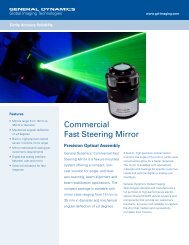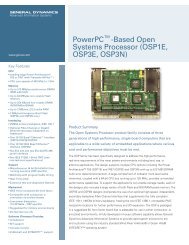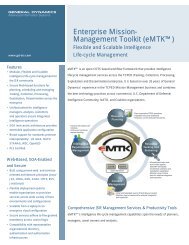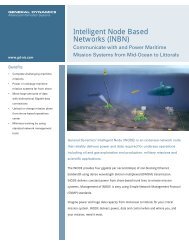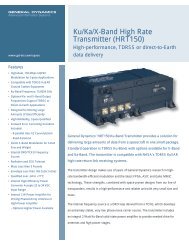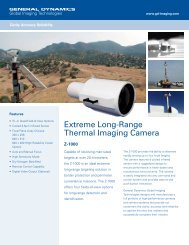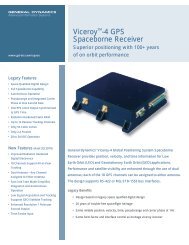Brush Type Manual - General Dynamics Global Imaging Technologies
Brush Type Manual - General Dynamics Global Imaging Technologies
Brush Type Manual - General Dynamics Global Imaging Technologies
You also want an ePaper? Increase the reach of your titles
YUMPU automatically turns print PDFs into web optimized ePapers that Google loves.
Pancake Resolvers >> <strong>Brush</strong>less Motors >><br />
<strong>Brush</strong> <strong>Type</strong> DC Motors<br />
Thermal Considerations<br />
On each of the following data pages there is<br />
a value for input power at stall torque.This<br />
power is dissipated as heat in the armature<br />
winding.The thermal resistance value given<br />
on the motor data pages can be used to<br />
determine the steady state temperature<br />
increase of the armature above ambient.<br />
The thermal resistance is measured with the<br />
motor suspended in the air. Air movement<br />
and a mounting structure can be used to<br />
improve a motor’s thermal resistance.<br />
The capacity of the motor to handle the<br />
load must also take into account the dutycycle<br />
which affects motor heating. A small<br />
motor with the capacity to drive the load<br />
intermittently may be inadequate when<br />
driving the same load under a more rigorous<br />
duty-cycle. Special care must be given to the<br />
thermal analysis of rare earth magnet motors<br />
since they can achieve peak torques which<br />
may cause excessive armature temperatures<br />
under continuous operation.<br />
Thermal Equations<br />
The following equations can be used to calculate<br />
the final temperature of the motor<br />
winding in a given application.The RMS<br />
torque must be known so that average<br />
power dissipation at 25°C can be calculated.<br />
P 25 = (T RMS /K t ) 2 (R 25 ) watts<br />
Where:<br />
P 25<br />
R 25<br />
K t<br />
= power dissipation @ 25C<br />
= resistance @ 25C<br />
= torque constant<br />
T RMS = RMS torque<br />
If the product of this power and the thermal<br />
resistance of the motor is greater than 253<br />
then a steady state temperature will never be<br />
9<br />
(800) 777-3393<br />
reached. A thermal runaway condition will<br />
exist.<br />
The final temperature in a nonrunaway system<br />
is:<br />
T F = .9212 P 25 x tpr + T AMB (1-.00394<br />
P 25 x tpr)<br />
Where:<br />
T F = final temperature<br />
tpr = thermal resistance<br />
T AMB = ambient temperature<br />
If the final temperature is greater than the<br />
allowable winding temperature, then cooling<br />
must be provided or a larger motor<br />
must be selected.<br />
Standard torque motor armatures are supplied<br />
with a maximum winding temperature<br />
capability of 155ºC. Our design and<br />
manufacturing methods allow availability of<br />
special units with temperature capability of<br />
220ºC, if required.<br />
Matching Motors to Requirement<br />
Matching motors to requirements frequently<br />
involves operating a motor below peak<br />
torque ratings. In such cases a simple derating<br />
procedure will permit selection of a<br />
standard motor.<br />
Significance of K m<br />
The ability of a permanent-magnet DC<br />
torque motor to convert electric power<br />
input to torque is proportional to the product<br />
of total magnetic flux linking to the<br />
winding from the field and the magneto-<br />
www.axsys.com<br />
><br />
Thermal Considerations &<br />
Matching Motors to Requirement




